Exploratory Engineering and Solar Sailing
 The 'Science' section in today's New York Times included an article about a space project that's been a long time coming. Accompanied by the gorgeous graphic above, reporter Kenneth Chang describes how The Planetary Society, a not-for-profit advocacy group for space exploration, was planning to launch some small spacecraft, starting in May 2015, and test drive a solar sail.A solar sail is an elegant idea. Light from the sun carries not just energy but momentum. This gentle but constant force, if captured by a sufficiently large sail, can propel a spacecraft until it is traveling hundreds of thousands of miles an hour. The concept of a solar sail is also an old one. Russian space visionary Konstantin Tsiolkovskii described the basic idea well before 1930. It was first picked up in the United States by science fiction writers. Then, a few weeks after the Soviets launched Sputnik I in October 1957, wunderkind physicist Richard L. Garwin added the rigor of numbers and equations. ((Richard L. Garwin, “Solar Sailing: A Practical Method of Propulsion within the Solar System,” Jet Propulsion, 1958, 28, 188-89; also, Colin McInnes. “On the Crest of a Sunbeam.” New Scientist, January 5 1991: 31-33.))
The 'Science' section in today's New York Times included an article about a space project that's been a long time coming. Accompanied by the gorgeous graphic above, reporter Kenneth Chang describes how The Planetary Society, a not-for-profit advocacy group for space exploration, was planning to launch some small spacecraft, starting in May 2015, and test drive a solar sail.A solar sail is an elegant idea. Light from the sun carries not just energy but momentum. This gentle but constant force, if captured by a sufficiently large sail, can propel a spacecraft until it is traveling hundreds of thousands of miles an hour. The concept of a solar sail is also an old one. Russian space visionary Konstantin Tsiolkovskii described the basic idea well before 1930. It was first picked up in the United States by science fiction writers. Then, a few weeks after the Soviets launched Sputnik I in October 1957, wunderkind physicist Richard L. Garwin added the rigor of numbers and equations. ((Richard L. Garwin, “Solar Sailing: A Practical Method of Propulsion within the Solar System,” Jet Propulsion, 1958, 28, 188-89; also, Colin McInnes. “On the Crest of a Sunbeam.” New Scientist, January 5 1991: 31-33.))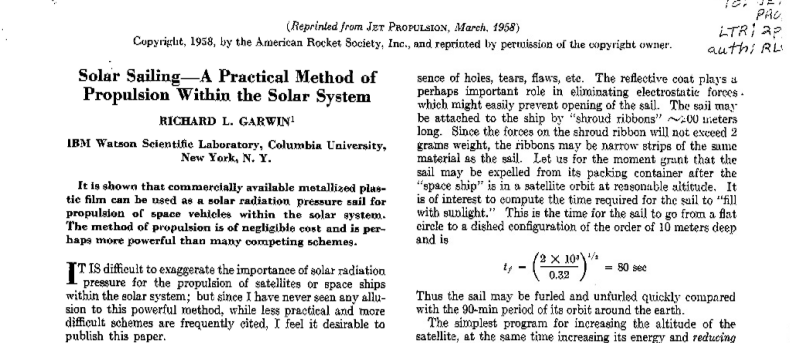 It is an evocative idea - a ship, its sails "filled" by sunlight, wending its way through the solar system. Clipper ships of space...a nice blend of the past and the future. The poster below was for the 1978 Japanese film Message from Space, described by as Japan's big-budget answer to Star Wars; notice the weird-looking craft in the upper right... (note: I'd love to hear from anyone who has seen this...the trailer is here. I'm amazed George Lucas didn't sue.)
It is an evocative idea - a ship, its sails "filled" by sunlight, wending its way through the solar system. Clipper ships of space...a nice blend of the past and the future. The poster below was for the 1978 Japanese film Message from Space, described by as Japan's big-budget answer to Star Wars; notice the weird-looking craft in the upper right... (note: I'd love to hear from anyone who has seen this...the trailer is here. I'm amazed George Lucas didn't sue.)
 Anyway -- as Garwin's 1958 article notes, "the principle involved is simply to make use of the pressure of the sun's light on a sail" in order to propel a craft. ((The day this article appeared, I received a nice email from Richard Garwin. He noted that his paper on solar sailing had actually been submitted to the IBM Journal of Research and Development in November 1956, a full year before it went to Jet Propulsion. So, Garwin was even more ahead of the curve than I originally noted.))This diagram, from this article, explains why and how:
Anyway -- as Garwin's 1958 article notes, "the principle involved is simply to make use of the pressure of the sun's light on a sail" in order to propel a craft. ((The day this article appeared, I received a nice email from Richard Garwin. He noted that his paper on solar sailing had actually been submitted to the IBM Journal of Research and Development in November 1956, a full year before it went to Jet Propulsion. So, Garwin was even more ahead of the curve than I originally noted.))This diagram, from this article, explains why and how: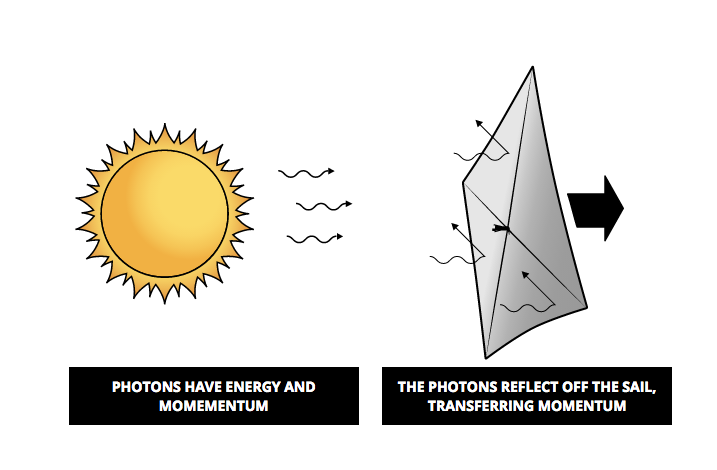 But, while the principle might be simple, developing a suitable sail and the means to deploy it isn't. So,despite the solar sail’s hypothetical potential for moving a spacecraft about the solar system, however, rockets remained the prevailing technology for space exploration during the Apollo era.The idea of a solar sail-powered craft picked up speed again in the 1970s. In mid-1976, as NASA recovered from its post-Apollo hangover, Bruce C. Murray, the new head of the Jet Propulsion Laboratory in Pasadena, proposed several new missions that he believed had “good technical content and popular appeal.” One idea Murray suggested was a rendezvous with Halley’s Comet, scheduled to return to the inner solar system in 1986, with a craft powered by a solar sail. If successful, the propulsion method could perhaps be adapted for other NASA missions. ((My colleague Peter J. Westwick has an excellent telling of this history in his prizewinning book Into the Black: JPL and the American Space Program, 1976-2004))The idea of solar sailing a spaceship to meet up with Halley’s Comet captured the public’s interest. As opposed to dirty, noisy rockets, with their obvious connections to ballistic missiles, solar sails appeared as a “soft technology” akin to solar and wind energy. But, in the end, high inflation and budget deficits scuttled the entire mission and no American craft flew to intercept Halley. ((European and Soviet missions, however, did successfully study the comet in 1986; John M. Logsdon, “Missing Halley's Comet: The Politics of Big Science,” Isis, 1989, 80, 2: 254-80.)) A small group of persistent NASA engineers, however, started the World Space Foundation to pursue their goal of building and testing a solar sail prototype using funds from private sources and efforts to find a gentler alternative to rockets continued into the 1980s. Solar sails became one of the projects that The Planetary Society - started in 1980 by Murray, Carl Sagan, and Louis Friedman - explored.
But, while the principle might be simple, developing a suitable sail and the means to deploy it isn't. So,despite the solar sail’s hypothetical potential for moving a spacecraft about the solar system, however, rockets remained the prevailing technology for space exploration during the Apollo era.The idea of a solar sail-powered craft picked up speed again in the 1970s. In mid-1976, as NASA recovered from its post-Apollo hangover, Bruce C. Murray, the new head of the Jet Propulsion Laboratory in Pasadena, proposed several new missions that he believed had “good technical content and popular appeal.” One idea Murray suggested was a rendezvous with Halley’s Comet, scheduled to return to the inner solar system in 1986, with a craft powered by a solar sail. If successful, the propulsion method could perhaps be adapted for other NASA missions. ((My colleague Peter J. Westwick has an excellent telling of this history in his prizewinning book Into the Black: JPL and the American Space Program, 1976-2004))The idea of solar sailing a spaceship to meet up with Halley’s Comet captured the public’s interest. As opposed to dirty, noisy rockets, with their obvious connections to ballistic missiles, solar sails appeared as a “soft technology” akin to solar and wind energy. But, in the end, high inflation and budget deficits scuttled the entire mission and no American craft flew to intercept Halley. ((European and Soviet missions, however, did successfully study the comet in 1986; John M. Logsdon, “Missing Halley's Comet: The Politics of Big Science,” Isis, 1989, 80, 2: 254-80.)) A small group of persistent NASA engineers, however, started the World Space Foundation to pursue their goal of building and testing a solar sail prototype using funds from private sources and efforts to find a gentler alternative to rockets continued into the 1980s. Solar sails became one of the projects that The Planetary Society - started in 1980 by Murray, Carl Sagan, and Louis Friedman - explored.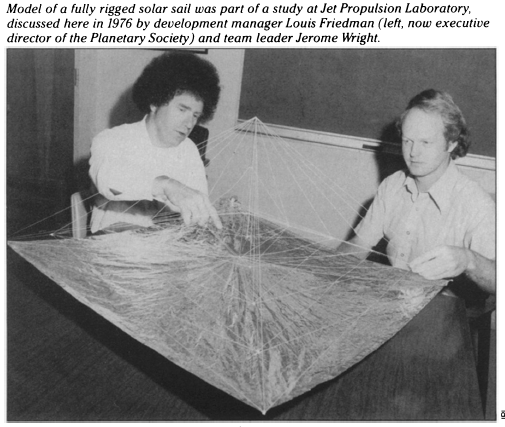 The revived interest in solar sails caught my attention because it reminded me of some early R&D done by engineer K. Eric Drexler. In my book The Visioneers, I describe how Drexler interest in the technological future started with a passion for space-based settlements and manufacturing in the style of Gerard O'Neill. As Whole Earth Catalog publisher Stewart Brand described him, by 1977, Drexler was already“old Space Colony hand,” a true believer who once predicted that he "probably won’t die on this planet.” In time, Drexler shifted his focus to promote what he initially called "molecular engineering" i.e. a nascent form of nanotechnology.The path to nanotechnology did not appear suddenly, however. After he finished his undergraduate degree at MIT in 1977, Drexler remained to do a master’s thesis in the Department of Aeronautics and Astronautics. For his research topic, the young engineer decided to design a “high performance solar sail system." This, in fact, became the title of his 1979 M.S. thesis.
The revived interest in solar sails caught my attention because it reminded me of some early R&D done by engineer K. Eric Drexler. In my book The Visioneers, I describe how Drexler interest in the technological future started with a passion for space-based settlements and manufacturing in the style of Gerard O'Neill. As Whole Earth Catalog publisher Stewart Brand described him, by 1977, Drexler was already“old Space Colony hand,” a true believer who once predicted that he "probably won’t die on this planet.” In time, Drexler shifted his focus to promote what he initially called "molecular engineering" i.e. a nascent form of nanotechnology.The path to nanotechnology did not appear suddenly, however. After he finished his undergraduate degree at MIT in 1977, Drexler remained to do a master’s thesis in the Department of Aeronautics and Astronautics. For his research topic, the young engineer decided to design a “high performance solar sail system." This, in fact, became the title of his 1979 M.S. thesis.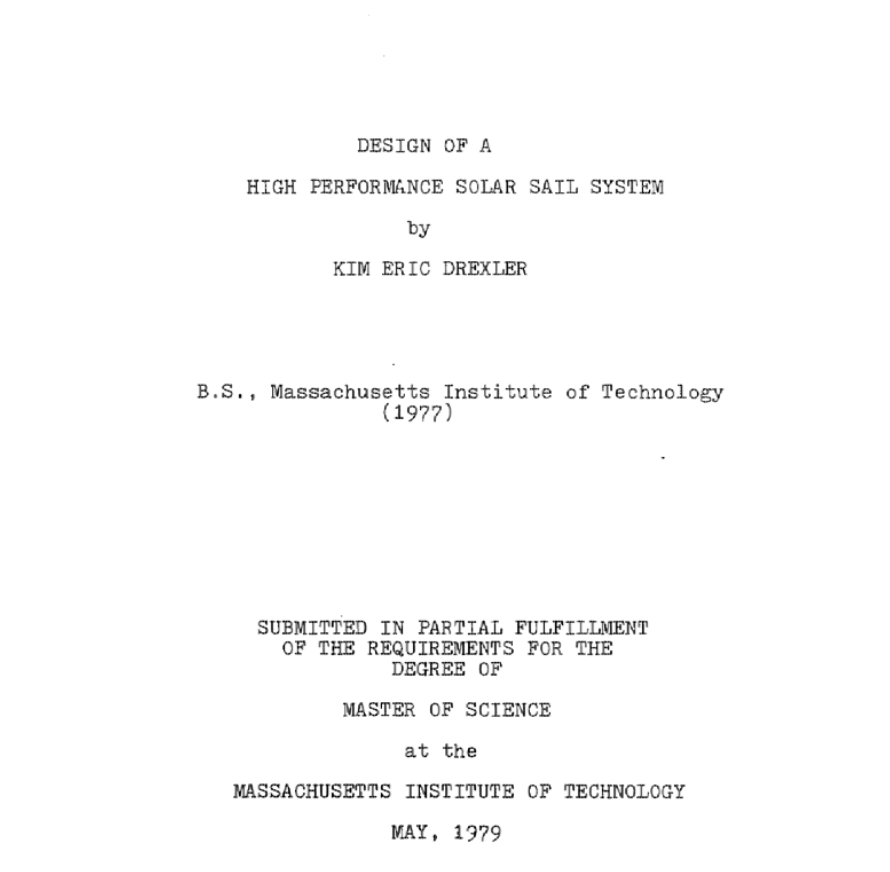 Drexler imagined this technology could be prove essential for future space exploration efforts. Funded by a graduate fellowship from the National Science Foundation, Drexler investigated what the best materials would be for a solar sail and designed a machine, compact enough to fit inside NASA’s space shuttle, for fabricating ultra-thin sheets of metal films in space. Drexler’s visioneering also included a system to rig these pieces into a solar sail a few kilometers in diameter and a method for maneuvering the craft. To make the basic proof of concept more robust, Drexler even fabricated some small pieces of metal films in an MIT lab. Drexler dubbed his design concept “Lightsail,” to make it clear that it would be propelled by photons, not the solar wind or some adaptation of solar power cells. Drexler thought the research he did at MIT was innovative enough to warrant filing for a patent in 1980:
Drexler imagined this technology could be prove essential for future space exploration efforts. Funded by a graduate fellowship from the National Science Foundation, Drexler investigated what the best materials would be for a solar sail and designed a machine, compact enough to fit inside NASA’s space shuttle, for fabricating ultra-thin sheets of metal films in space. Drexler’s visioneering also included a system to rig these pieces into a solar sail a few kilometers in diameter and a method for maneuvering the craft. To make the basic proof of concept more robust, Drexler even fabricated some small pieces of metal films in an MIT lab. Drexler dubbed his design concept “Lightsail,” to make it clear that it would be propelled by photons, not the solar wind or some adaptation of solar power cells. Drexler thought the research he did at MIT was innovative enough to warrant filing for a patent in 1980: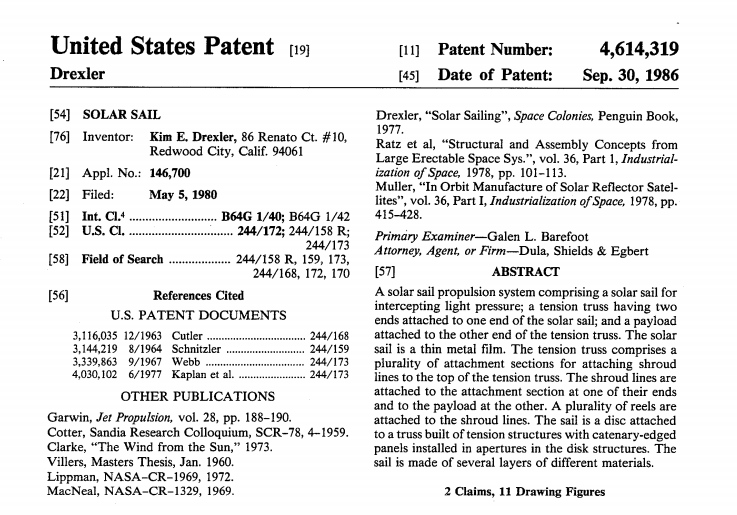 And, of course, he promoted his ideas for solar sailing to fellow pro-space enthusiasts, particularly those in the L5 Society. An article he wrote for the February issue of Smithsonian brought the idea to an even wider audience.
And, of course, he promoted his ideas for solar sailing to fellow pro-space enthusiasts, particularly those in the L5 Society. An article he wrote for the February issue of Smithsonian brought the idea to an even wider audience.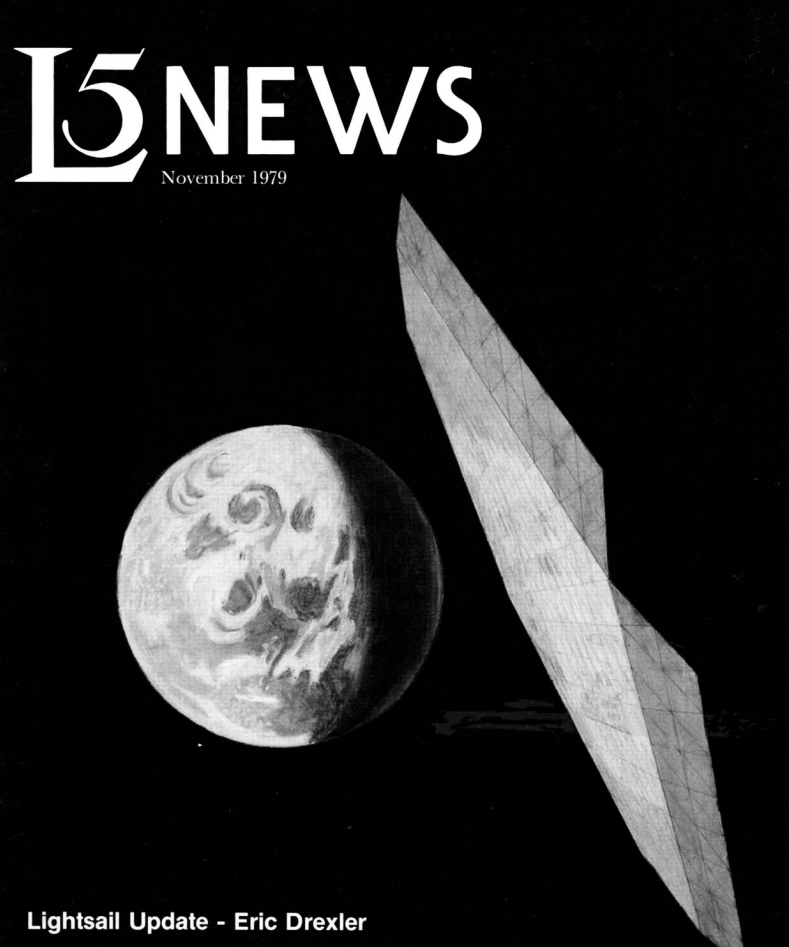 Drexler eventually began using the term “exploratory engineering,” an expression that well describes his approach to designing solar sails. Unlike the conventional engineering, which aims to build specific things and looks to a relatively short-term horizon, exploratory engineering for Drexler meant “designing things that we can’t yet build.” Today's NYT article drove home the point that now we can build them.
Drexler eventually began using the term “exploratory engineering,” an expression that well describes his approach to designing solar sails. Unlike the conventional engineering, which aims to build specific things and looks to a relatively short-term horizon, exploratory engineering for Drexler meant “designing things that we can’t yet build.” Today's NYT article drove home the point that now we can build them. With the launch of The Planetary Society's LightSail craft - perhaps the name owes a debt to Drexler - planned for this coming May, decades worth of dreaming and exploratory engineering will finally get a test-flight in space.
With the launch of The Planetary Society's LightSail craft - perhaps the name owes a debt to Drexler - planned for this coming May, decades worth of dreaming and exploratory engineering will finally get a test-flight in space.